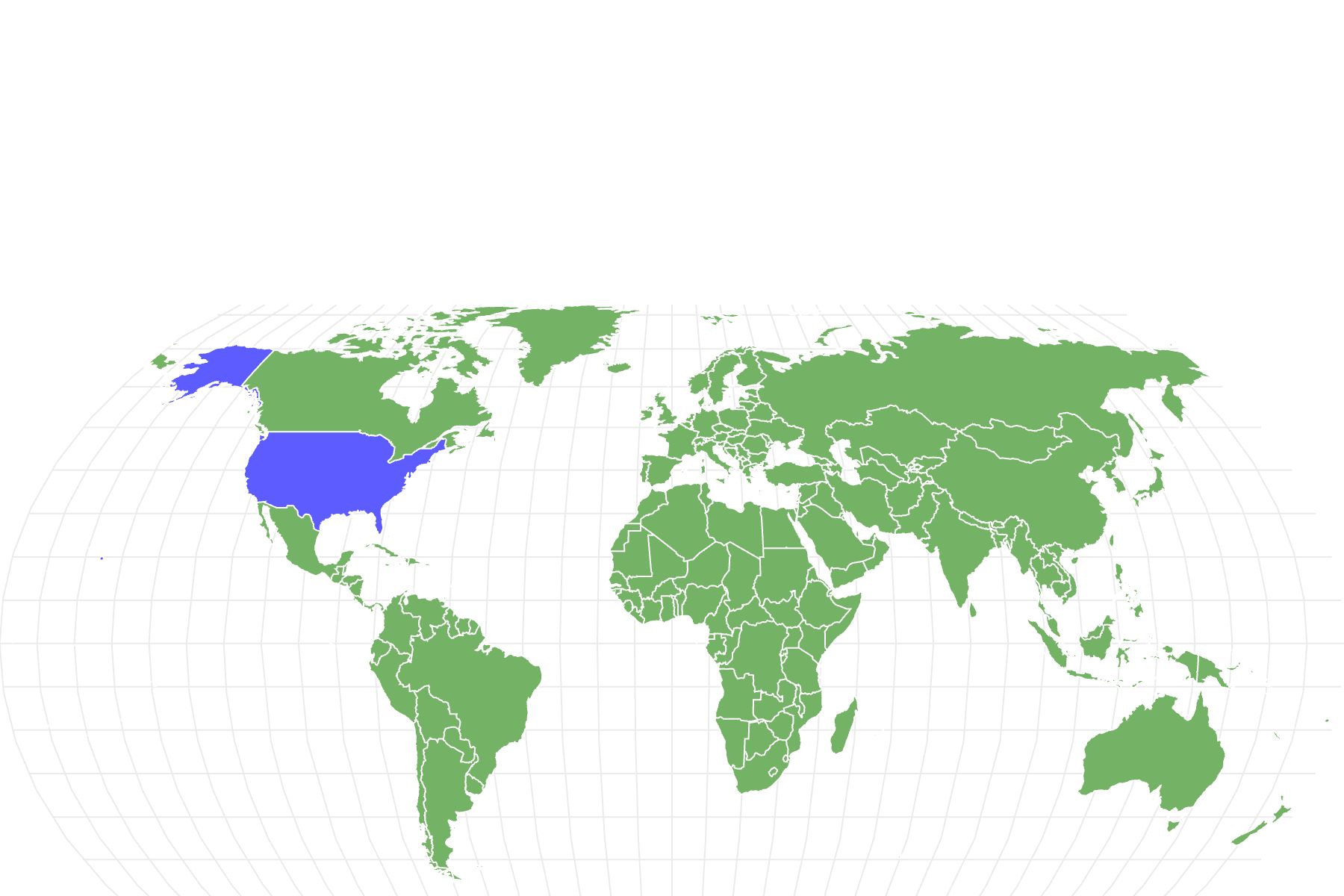Uinta Ground Squirrel
Urocitellus armatus
The squirrel is named after the Uinta Mountains, which are part of the Rocky Mountain range and are found in Utah and Wyoming.
Advertisement
Uinta Ground Squirrel Scientific Classification
- Kingdom
- Animalia
- Phylum
- Chordata
- Class
- Mammalia
- Order
- Rodentia
- Family
- Sciuridae
- Genus
- Urocitellus
- Scientific Name
- Urocitellus armatus
Read our Complete Guide to Classification of Animals.
Uinta Ground Squirrel Conservation Status
Uinta Ground Squirrel Facts
- Prey
- Earthworms, insects, other arthropods
- Name Of Young
- Pup, kitten, kit
- Group Behavior
- Gregarious
- Fun Fact
- The squirrel is named after the Uinta Mountains, which are part of the Rocky Mountain range and are found in Utah and Wyoming.
- Biggest Threat
- predators
- Other Name(s)
- Chiseler or potgut
- Gestation Period
- 28 days
- Litter Size
- four to eight
- Habitat
- Mountain meadows, fields, pastures, lawns, moist locations that support lots of vegetation, including aquatic plants.
- Predators
- Hawks, weasels, coyotes, badgers, grizzly bears
- Diet
- Herbivore
- Type
- mammal
- Common Name
- Uinta ground squirrel
- Number Of Species
- 1
- Location
- Montana, Utah, Wyoming and Idaho
- Group
- colony
Uinta Ground Squirrel Physical Characteristics
- Color
- Brown
- Grey
- Skin Type
- Fur
- Top Speed
- 32 mph
- Lifespan
- seven years
- Weight
- 7.4 to 15 ounces
- Length
- 11-12 inches
- Age of Sexual Maturity
- One year for females, about one and a half years for males
- Age of Weaning
- 22 days
View all of the Uinta Ground Squirrel images!
”Potgut of the Mountains”
This little ground squirrel, also called the chiseler or potgut, knows to make hay while the sun shines. For nine months out of the year, it is sleeping in its burrow in one of the four mountain states where it lives. When the weather gets too hot it estivates, and that estivation segues directly into a long period of hibernation. When the squirrel finally wakes up it has to find food, find a mate, raise its babies, and hoard seeds for the next nap time. Read on to learn more about this fascinating and unusual rodent.
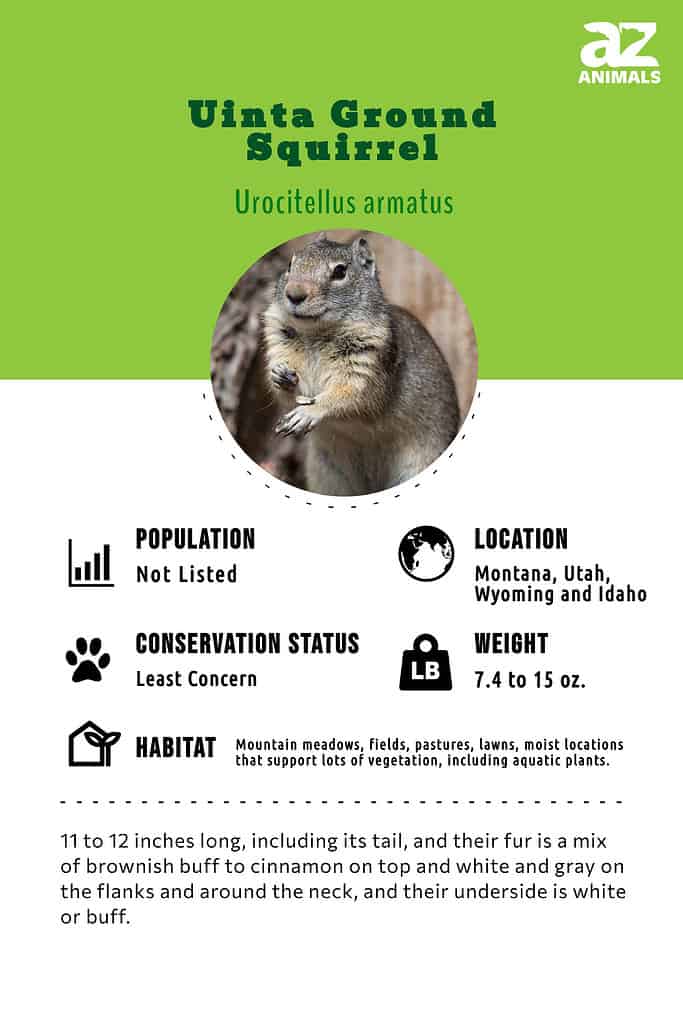
Four Incredible Uinta Ground Squirrel Facts!
Here are four amazing facts about the Uinta ground squirrel:
- Yellowstone Park, found mostly in Wyoming, is a good place to find Uinta ground squirrels.
- They are surprisingly aggressive toward each other even though they often live in colonies. Pregnant females are especially territorial.
- Scientists believe that the action of their gut biome allows estivating and hibernating ground squirrels to emerge unscathed after such a long time without eating.
- They are good swimmers and aquatic plants make up part of their diet.

Uinta ground squirrel are surprisingly aggressive toward each other even though they often live in colonies.
©iStock.com/Nancy Strohm
Scientific Name, Types, and Evolution
The Uinta ground squirrel is known by at least two scientific names. One is Urocitellus armatus and the other is Spermophilus armatus. Urocitellus comes from the Latin words for “tail” which is uro and citellus which means “ground squirrel.” Spermophilus comes from the Greek word for “seed,” which is sperma, and the Greek word for “lover” which is philos. Armatus is Latin for “armed.” There are no subspecies.
Like other ground squirrels, the Uinta species evolved to be able to thrive without depending on tree living. By burrowing and social development, they found ways to survive and prosper in many environments throughout the world.
Appearance
The Uinta ground squirrel is a small animal though it is on the larger side for a ground squirrel. It grows from 11 to 12 inches long, including its tail. After their long period of dormancy, they weigh about 7.4 ounces on average and eat until they weigh close to 15 ounces.
The colors of the fur are a mix of brownish buff to cinnamon on top and white and gray on the flanks and around the neck. The underside is white or buff. The tail is about 2.4 to 3.1 inches long and is gray on top and buff or white below. The colors of the tail help in the identification of the rodent and distinguish it from the Belding’s ground squirrel, whose tail is reddish.
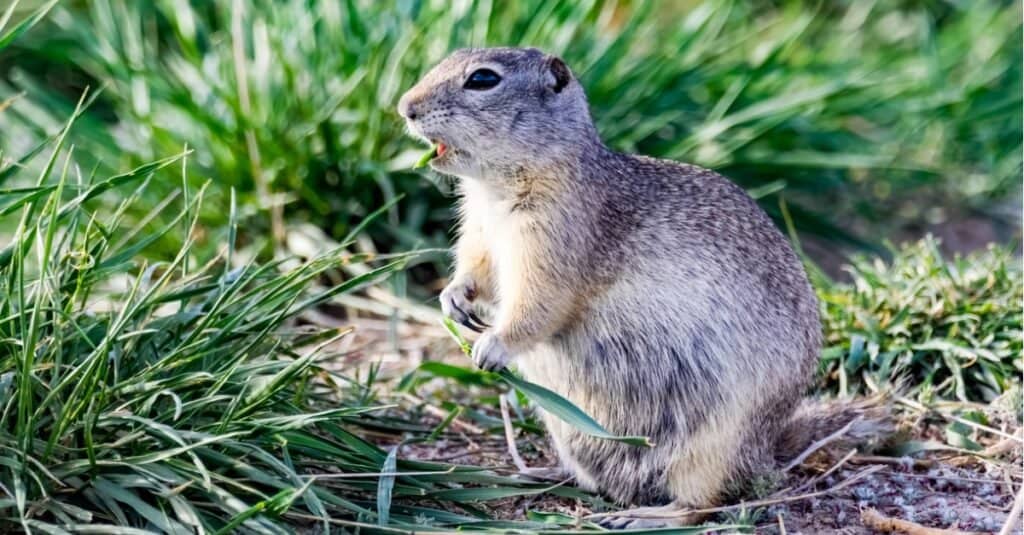
©iStock.com/Michael Chatt
Uinta Ground Squirrel vs. Prairie Dog
It is easy for a person to mistake a potgut for a prairie dog. They are both types of ground squirrels and identification can be tricky. The animals differ not just in looks but in the way they behave.
First, the two belong to different genera. The ground squirrel belongs to either Urocitellus or Spermophilus, while the prairie dog is a member of the Cynomys genus. By the way, the name means “dog-mouse” even though the prairie dog is neither a dog nor a mouse. Though there’s only one type of Uinta ground squirrel, there are five types of prairie dog.
Physical traits that help with identification include the size of the rodents. Grown prairie dogs are much larger than grown Uinta ground squirrels. They range from 12 to 16 inches long and weigh between one and three pounds. The mix-up comes when there’s a juvenile prairie dog next to an adult Urocitellus armatus.
Also, the potgut has a white ring around its eye that the prairie dog lacks. The white-tailed prairie dog has black spots on the cheeks and above the eyes, and the black-tailed prairie dog has, as its name says, a black tail. The endangered Utah prairie dog is most likely to be mistaken for the Uinta ground squirrel as their ranges overlap somewhat, and the Utah prairie dog is smaller than other types of prairie dog. The one thing that distinguishes this prairie dog from the ground squirrel is its black eyebrows.
Prairie dogs are famous for living in “towns” that can comprise thousands of individuals and cover many acres. Uinta ground squirrel colonies rarely have more than two dozen individuals. Prairie dogs are affectionate with members of their family group and kiss and groom each other frequently, but potguts are prickly even with family members. Prairie dogs might tussle with strangers.
What both rodents do share is females staying in their natal group and males leaving. Both Uinta ground squirrel males and male prairie dogs move into other family groups or colonies. Prairie dog mothers tend to be attentive to their pups, but Urocitellus armatus mothers abandon their young after they’re weaned.
One interesting and odd thing about the potgut is that it is only above ground for two or three months out of the entire year. Prairie dogs stay above ground much longer. Indeed, they don’t hibernate, but if the weather is cold, they will enter their burrows and sleep until it warms up. The lifespan of the Uinta ground squirrel and the Utah prairie dog is similar. Female prairie dogs can live eight years in the wild, and the lifespan of the ground squirrel is about seven years.
Behavior
These ground squirrels do live in groups, but it seems that they barely tolerate each other. This is especially true of females and even more true when they are pregnant. They often squeak, chirp, growl, chatter their teeth, and bristle their tails at each other. This can lead to a wrestling match which ends with one squirrel chasing the other away.
They also use alarm calls. A chirp is believed to warn against flying predators and a trill is used to warn of terrestrial predators.
When they are above ground, these rodents are active during the day. When it gets too hot, they retreat into their burrows and estivate. Adults start estivation first, followed by juveniles. Then, as the weather grows cold they go into hibernation and do not emerge from their burrows until early spring. Adults are ready to breed immediately after they wake up, and the males lay down scents by wiping the scent glands on their faces on the ground and calling for mates.
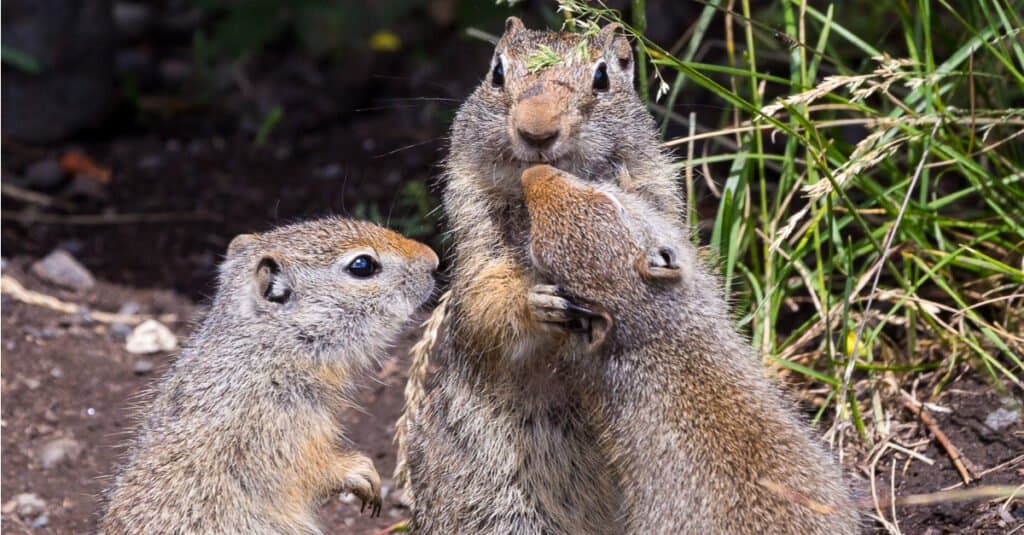
Uinta ground squirrels often squeak, chirp, growl, chatter their teeth, and bristle their tails at each other.
©Michael Chatt/Shutterstock.com
Habitat
The Uinta ground squirrel lives in open areas with lots of vegetation between 4,000 and 8,010 feet above sea level. These habitats include mountain meadows, valleys, mountain grassland, shrublands, and other places where the soil is soft enough for it to dig its burrow.
Diet
These ground squirrels are mostly herbivores. They eat seeds, which gave rise to one of the generic names. They also eat grass, forb leaves, insects, spiders, earthworms, and human food. Some visitors to Yellowstone Park and other locations are charmed when one of these little squirrels comes up to them for a treat. Farmers are less charmed as the potgut steals seeds from farms and gardens to store in its burrow during its long nap. The rodents are especially fond of succulents and will enter the water to add aquatic plants to their diet.
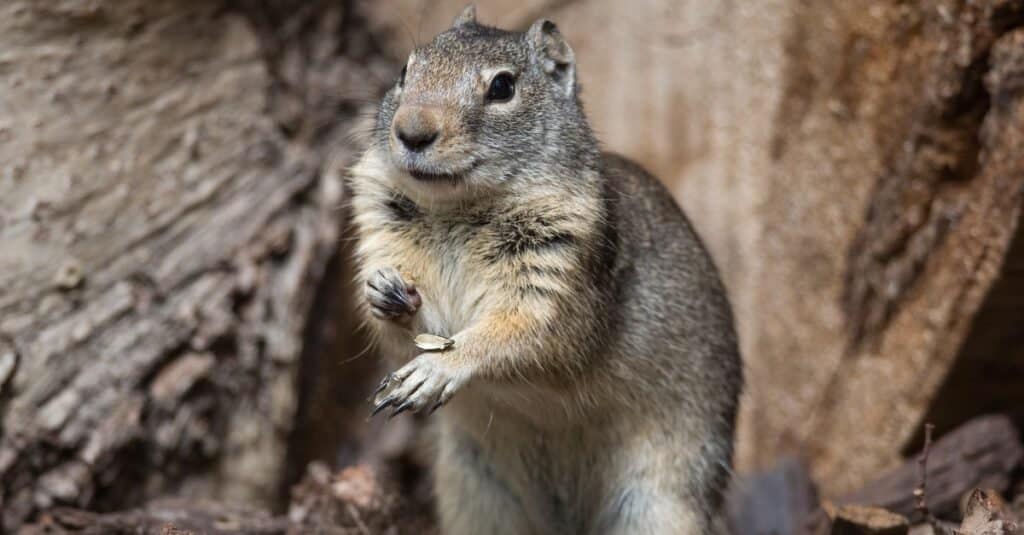
Uinta ground squirrel mostly seeds, which gave rise to one of the generic names
©iStock.com/Savageslc
Predators and Threats
As a small rodent, the potgut has a variety of other animals that like to kill and eat it. They include birds of prey, badgers, weasels, coyotes, and grizzly bears. Humans also hunt them and run them over with vehicles.
Reproduction and Life Cycle
Potguts are ready to reproduce immediately after they leave hibernation in either March or April. Males emerge first, followed a short time later by the females. Time is of the essence since the female is only receptive for one afternoon a few days after she leaves hibernation. Mating happens underground, and males are polygynous.
The female is pregnant for about 23 to 26 days and has about five pups per litter. They’re weaned when they’re 22 days old and leave their mother’s burrow at the same time. Even though they are still small, she takes no further care of them, and they are left to fend for themselves. Females are ready to breed when they’re about a year old, and males are ready when they are a little older. The Uinta ground squirrel’s lifespan is about seven years.
Population
The potgut’s range is small when compared to a prairie dog’s. It only lives in parts of four states, and its numbers haven’t been counted. Still, its status is least concern.
View all 16 animals that start with UUinta Ground Squirrel FAQs (Frequently Asked Questions)
Are Uinta Ground Squirrel s carnivores, herbivores, or omnivores?
These little rodents are mostly herbivores.
What is a Uinta ground squirrel?
The Uinta ground squirrel is a rodent that belongs either to the Urocitellus or Spermophilus genus.
What do Uinta ground squirrels eat?
They eat seeds, leaves, nuts, grains, and an occasional invertebrate such as an insect or earthworm.
Where do Uinta ground squirrels live?
They are found in meadows and grassy, open habitats at fairly high elevations in western Wyoming, north and central Utah, eastern Idaho, and the southwest of Montana.
Are Uinta squirrels endangered?
These ground squirrels aren’t endangered, even though they have a small geographical range. Their conservation status is least concern.
What's the difference between ground squirrels and chipmunks?
Ground squirrels differ from chipmunks in their size, markings, and habitats. Read more about their differences here!
Thank you for reading! Have some feedback for us? Contact the AZ Animals editorial team.
Sources
- ITIS / Accessed January 29, 2022
- wildlifenorthamerica.com / Accessed January 29, 2022
- The Conversation / Accessed January 29, 2022
- Yellowstone / Accessed January 29, 2022
- National Park Service / Accessed January 29, 2022
- The Green Life / Accessed January 29, 2022

